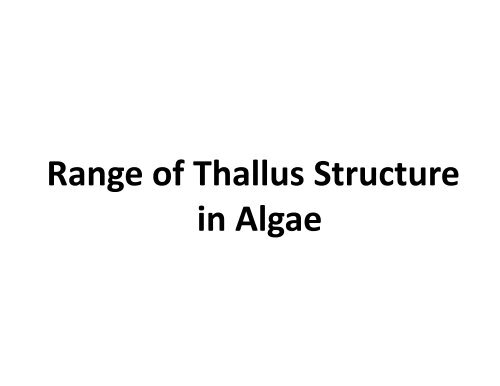Range of Thallus Structure in Algae
Range of Thallus Structure in Algae
Range of Thallus Structure in Algae
Create successful ePaper yourself
Turn your PDF publications into a flip-book with our unique Google optimized e-Paper software.
<strong>Range</strong> <strong>of</strong> <strong>Thallus</strong> <strong>Structure</strong><br />
<strong>in</strong> <strong>Algae</strong>
<strong>Range</strong> <strong>of</strong> <strong>Structure</strong> <strong>in</strong> <strong>Algae</strong><br />
There is a great diversity <strong>in</strong> the<br />
thallus structure <strong>in</strong> algae. They vary<br />
from t<strong>in</strong>y s<strong>in</strong>gle-celled species one<br />
micrometer <strong>in</strong> diameter to giant<br />
seaweeds over 50 meters long e.g.<br />
Macrocystis. Broadly, all algae may<br />
be divided <strong>in</strong>to two types regard<strong>in</strong>g<br />
their structure.
There are two types <strong>of</strong><br />
algae regard<strong>in</strong>g their<br />
structure.<br />
(1) Unicellular <strong>Algae</strong><br />
(2) Multicellular <strong>Algae</strong>
1) Unicellular <strong>Algae</strong>: These are <strong>of</strong><br />
follow<strong>in</strong>g two types:<br />
(a) Non-motile: Non-motile unicells<br />
(without flagella — organ for<br />
locomotion). Many unicellular algae do<br />
not possess any outgrowth for<br />
locomotion. Example – Chlorella.
Chlorella
) Motile: These algae are s<strong>in</strong>gle cells. All<br />
the vital function <strong>of</strong> life are performed by<br />
the s<strong>in</strong>gle cell The unicellular algae are all<br />
sizes and shapes. They range from small<br />
spherical cells to large irregular shaped cells.<br />
The unicellular forms may be spherical,<br />
oblong, pear-shaped or sometimes<br />
elongated bear<strong>in</strong>g flagella<br />
eg. Chlamydomonas, Euglena, Carteria.
Chlamydomonas
Euglena
Carteria<br />
A Unicellular<br />
alga with 4<br />
flagella
(2) Multicellular <strong>Algae</strong>:<br />
These are <strong>of</strong> follow<strong>in</strong>g k<strong>in</strong>ds:<br />
(a) Non-motile Colony:<br />
Number <strong>of</strong> cells <strong>in</strong> these<br />
colonies is <strong>in</strong>def<strong>in</strong>ite and they<br />
are non motile e.g.<br />
Hydrodictyon, Pediastrum.
Hydrodictyon
Pediastrum
(b) Motile Colony:<br />
In these algae, def<strong>in</strong>ite<br />
number <strong>of</strong> cells are found<br />
and these are motile, e.g.<br />
Scenedesmus, Gonium<br />
(small colony), Volvox (big<br />
colony).
Scenedesmus<br />
Only 4-celled colony
Gonium A 16 celled colony
Volvox
(c) Amorphous Colony:<br />
They are also called as<br />
Palmelloid forms: <strong>Algae</strong> cells<br />
<strong>in</strong> these are surrounded by a<br />
viscous mucilalg<strong>in</strong>ous<br />
substance e.g. Microcystis,<br />
Tetraspora.
Microcystis
Colony<br />
Tetraspora<br />
Individual cells
(d) Dendroid colony:<br />
Cells <strong>of</strong> these forms produce<br />
mucilag<strong>in</strong>ous substance and<br />
are folded <strong>in</strong> such a manner<br />
that they look like branches<br />
<strong>of</strong> a plant, e.g. D<strong>in</strong>obryon.
D<strong>in</strong>obryon
(e) Filamentous:<br />
Filamentous algae (float<strong>in</strong>g or attached. The<br />
simplest filamentous algae consist <strong>of</strong> a<br />
thallus (body) <strong>of</strong> a s<strong>in</strong>gle cha<strong>in</strong> <strong>of</strong> cells. This<br />
is the result <strong>of</strong> cell division <strong>in</strong> one plane only.<br />
The filaments may be Unbrached<br />
filamentous forms :-Such type <strong>of</strong> thalli are<br />
found <strong>in</strong> many algae and consist <strong>of</strong> a straight<br />
row <strong>of</strong> cells. As a free liv<strong>in</strong>g e.g. Spirogyra<br />
or attached e.g. Ulothrix and Oedogonium.
Holdfast Cell<br />
Substratum<br />
Ulothrix<br />
An Attached<br />
alga
Oedogonium<br />
An Attached alga
These are <strong>of</strong> follow<strong>in</strong>g types:<br />
(i) Simple Unbranched<br />
filaments, e.g. Ulothrix<br />
(ii) Simple branched filaments,<br />
e.g. Cladophora<br />
(iii) Psudobranched filaments,<br />
e.g. Scytonema
Ulothrix<br />
Unbranched<br />
filamentous<br />
alga with<br />
clear girdle<br />
shape<br />
chloroplast<br />
and nucleus
Cladophora
Scytonema<br />
Show<strong>in</strong>g<br />
Psuedobranch<strong>in</strong>g<br />
(Not truly branched)
(iv) Heterotrichous forms<br />
(heteros =different): Some cells <strong>in</strong><br />
the filaments divide several times<br />
<strong>in</strong> different planes result<strong>in</strong>g <strong>in</strong> two<br />
parts. <strong>Thallus</strong> consists <strong>of</strong> two parts,<br />
i.e. horizontally runn<strong>in</strong>g ma<strong>in</strong><br />
shoot/trichome and a vertical erect<br />
trichome/shoot e.g.<br />
Draparnaldiopsis, Chara
Draparnaldiopsis
Chara
(f) Siphonous or Siphonaceous:<br />
The thallus undergoes repeated<br />
nuclear division without the<br />
accompany<strong>in</strong>g formation <strong>of</strong> cell<br />
walls. As a result tubular structure<br />
with the mult<strong>in</strong>uclear cytoplasm<br />
l<strong>in</strong><strong>in</strong>g is formed known as<br />
coenocytic as <strong>in</strong> siphonales e.g.<br />
Vaucheria, Caulerpa.
Vaucheria
Caulerpa
Valonia
(g) Parenchymatous:<br />
Seaweeds made up <strong>of</strong> "boxy" cells like<br />
those <strong>of</strong> higher plants are termed<br />
parenchymatous. They may be<br />
membranous like Ulva, the sea lettuce.<br />
In these algae, cell division takes place<br />
on different sides with the result that<br />
they become parenchymatous, e.g. Ulva,<br />
Macrocystis.
U l v a
Macrocystis
(g) Psuedoparenchymatous:<br />
Psuedoparenchymatous algae<br />
have thalli that superficially<br />
resemble parenchyma, but which<br />
are actually composed <strong>of</strong><br />
appressed filaments or<br />
amorphous cell aggregates. e.g.<br />
Monostroma
Monostroma


